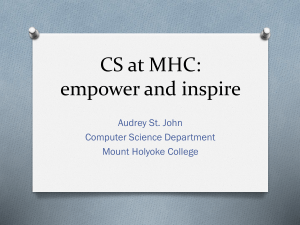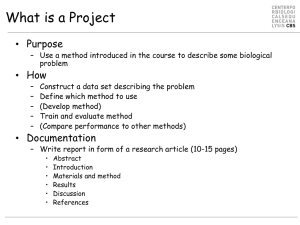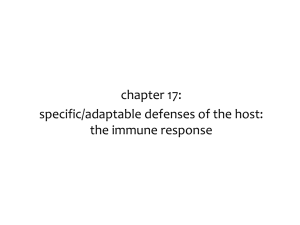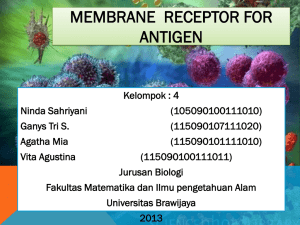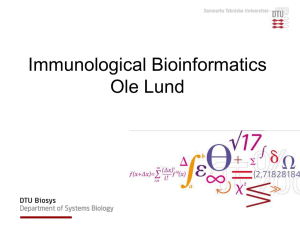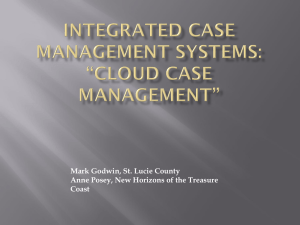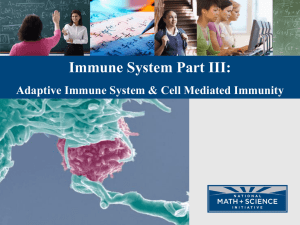Chapter 15
advertisement
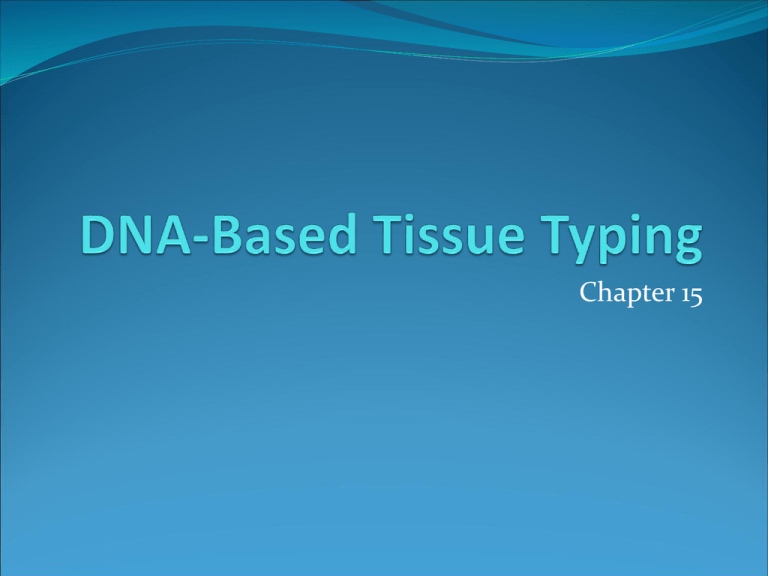
Chapter 15 Major Histocompatibility Complex Major Histocompatibility Complex Cluster of genes found in all mammals Its products play role in discriminating self/non-self Participant in both humoral and cell-mediated immunity MHC Act As Antigen Presenting Structures In humans MHC is found on chromosome 6 Referred to as HLA complex In mice, MHC is found on Chromosome 17 Referred to as H-2 complex The Major Histocompatibility Complex (MHC) The MHC is located on chromosome 6. 1 Mb 2 Mb baba ba bbbba HLA- DP 3 Mb 4 Mb a b DQ DR Class II TNF B C Class III A Class I The MHC contains the human leukocyte antigen (HLA) and other genes. Classes of MHC Genes Class I MHC genes Glycoproteins expressed on all nucleated cells Major function to present processed Ags to TC Class II MHC genes Glycoproteins expressed on M, B-cells, DCs Major function to present processed Ags to TH Class III MHC genes Products that include secreted proteins that have immune functions. Ex. Complement system, inflammatory molecules Genes of the Major Histocompatibility Locus MHC region Gene products Tissue location Function HLA-A, HLA-B, HLA-C All nucleated cells Identification and destruction of abnormal or infected cells by cytotoxic T cells Class II HLA-D B lymphocytes, monocytes, macrophages, dendritic cells, activated T cells, activated endothelial cells, skin (Langerhans cells) Identification of foreign antigen by helper T cells Class III Complement C2, C4, B Plasma proteins Defense against extracellular pathogens Cytokine genes TNFa, TNFb Plasma proteins Cell growth and differentiation Class I Class I MHC Genes found in regions A, B and C in humans (K and D in mice) Class II MHC Genes found in regions DR, DP and DQ (IA and IE In mice) Class I and Class II MHC share structural features Both involved in APC Class III MHC have no structural similarity to Class I and II Ex. TNF, heat shock proteins, complement components MHC Genes Are Polymorphic MHC products are highly polymorphic Vary considerably from person to person However, crossover rate is low 0.5% crossover rate Inherited as 2 sets (one from father, one from mother) Haplotype refers to set from mother or father MHC alleles are co-dominantly expressed Both mother and father alleles are expressed Inheritance Of HLA Haplotypes Class I MHC Molecule Comprised of 2 molecules a chain (45 kDa), transmembrane b2-microglobulin (12 kDa) Non-covalently associated with each oth Association of a chain and b2 is required for surface expression a chain made up of 3 domains (a1, a2 and a3) b2-microglobulin similar to a3 a1 and a2 form peptide binding cleft Fits peptide of about 8-10 a/a long a3 highly conserved among MHC I molecules Interacts with CD8 (TC) molecule Class II MHC Molecule Comprised of a and b chains a chain and b chain associate non-covalently a and b chains made up of domains a1 and a2 (a chain) b1 and b2 (b chain) a1and b1 form antigen binding cleft a and b heterodimer has been shown to dimerize CD4 molecule binds a2/b2 domains Class I And II Specificity Several hundred allelic variants have been identified However, up to 6 MHC I and 12 MHC II Molecules are expressed in an individual Enormous number of peptides needs to be presented using these MHC molecules To achieve this task MHC molecules are not very specific for peptides (unlike TCR and BCR) Promiscuous binding occurs A peptide can bind a number of MHC An MHC molecule can bind numerous peptides Class I And II Diversity And Polymorphism MHC is one of the most polymorphic complexes known Alleles can differ up to 20 a/a Class I Alleles: 240 A, 470 B, 110 C Class II Alleles: HLA-DR 350 b, 2 a! HLA-DR b genes vary from 2-9 in different individuals!!!, 1 a gene (a can combine with all b products increasing number of APC molecules) DP (2 a, 2 b) and DQ (2 a, 3 b) Class I MHC Peptides Peptides presented thru MHC I are endogenous proteins As few as 100 Peptide/MHC complexes can activate TC Peptide Features size 8-10 a/a, preferably 9 Peptides bind MHC due to presence of specific a/a found at the ends of peptide. Ex. Glycine @ position 2 Class II MHC Peptides Peptides presented thru MHC II are exogenous Processed thru endocytic pathway Peptides are presented to TH Peptides are 13-18 a/a long Binding is due to central 13 a/a Longer peptides can still bind MHC II Like a long hot dog MHC I peptides fit exactly, not the case with MHC II peptides MHC Expression Expression is regulated by many cytokines IFNa, IFNb, IFN and TNF increase MHC expression Transcription factors that increase MHC gene expression CIITA (transactivator), RFX (transactivator) Some viruses decrease MHC expression CMV, HBV, Ad12 Reduction of MHC may allow for immune system evasion Human Leukocyte Antigens (HLA) Human leukocyte antigens, the MHC gene products, are membrane proteins that are responsible for rejection of transplanted organs and tissues. a 1 b1 HLA-D a 2 a1 a 2 b2 a3 Cell membrane a chain b chain a chain b 2 microglobulin Human Leukocyte Antigens (HLA) HLA-gene sequences differ from one individual to another. a.CGG GCC GCG GTG GAC ACC TAC TGC AGA CAC AAC TAC GGG GTT GGT GAG AGC TTC ACA CGG GCC GCC GTG GAC ACC TAT TGC AGA CAC AAC TAC GGG GCT GTG GAG AGC TTC ACA CGG GCC GCC GTG GAC ACC TAT TGC AGA CAC AAC TAC GGG GCT GTG GNN NNN NNN NNN b.Also written as: CGG GCC GCG GTG GAC ACC TAC TGC AGA CAC AAC TAC GGG GTT GGT GAG AGC TTC ACA --- --- --- --- --- --- --T --- --- --- --- --- --- -C - -TG --- --- --- ----- --- --C --- --- --- --T --- --- --- --- --- --- -C- -TG -** Each sequence is a different allele. *** *** *** HLA Allele Nomenclature A standard nomenclature has been established by the World Health Organization (WHO) Nomenclature Committee. Gene region Subregion HLA-DRB1 Gene locus a- or b-chain polypeptide A small “w” is included in HLA-C, HLAB-4, and HLAB- 6 allele nomenclature: HLA-Cw, HLABw-4, HLABw-6. HLA alleles are inherited in blocks as haplotypes. A24 A30 A1 A6 alleles haplotype Cw1 B14 Cw3 B7 DR14 DR15 X Cw1 B12 Cw7 B44 DR5 DR14 A24 A6 A1 A30 A6 A30 A24 A1 Cw1 B14 Cw7 B44 Cw1 B12 Cw3 B7 Cw7 B44 Cw3 B7 Cw1 B14 Cw1 B12 DR14 DR14 DR5 DR15 DR14 DR15 DR14 DR5 HLA Typing Every person (except identical twins) has different sets of HLA alleles. Transplanted organs are allografts, in which the donor organ and the recipient are genetically different. Compatibility (matching) of the HLA of the donor and the recipient increases the chance for a successful engraftment. Matching is determined by comparing alleles. Resolution is the level of detail with which an allele is determined. Serological Typing Recipient antihuman antibodies are assessed by crossmatching to donor lymphocytes. Lymphocytes from organ donor or lymphocytes of known HLA types Recipient serum Positive reaction to antibody kills cells: dead cells pick up dye. Negative reaction to antibody: cells survive and exclude dye. Serological Typing Using Bead Arrays Recipient antihuman antibodies are assessed by crossmatching to known lymphocyte antigens conjugated to microparticles. Results are assessed by flow cytometry. Beads conjugated to different lymphocyte antigens Serum antibodies Positive for antibody (Wash) Fluorescent reporter antibodies Negative for antibody Other Serological Typing Methods Cytotoxic and noncytotoxic methods with flow cytometry detection. Enzyme-linked immunosorbent assay (ELISA) with solubilized HLA antigens. Mixed lymphocyte culture measuring growth of lymphocytes activated by cross-reactivity. Measure of HLA-protein mobility differences in one-dimensional gel isoelectric focusing or twodimensional gel electrophoresis. ELISA Class I and class II are solid phase enzyme linked immuno sorbent assays (ELISA). Microtitre plates are coated with different highly purified human HLA class I and II glycoproteins. If the sample being tested contains specific antibodies against HLA class I or class II, they will bind to the antigens in the wells of the microtitre plate. ELISA The resulting antibody-antigen complex is detected using a specific enzyme-labelled (alkaline phosphatase) antibody which is directed against human IgG (conjugate). The presence of bound antibodies is demonstrated by adding a chromogenic substrate (PNPP) which results in a coloured product. The reaction is interpreted by a photometric reader. MLC Measure of histocompatibility at the hl-a locus. Peripheral blood lymphocytes from two individuals are mixed together in tissue culture for several days. Lymphocytes from incompatible individuals will stimulate each other to proliferate significantly (measured by tritiated thymidine uptake) whereas those from compatible individuals will not. MLC In the one-way MLC test, the lymphocytes from one of the individuals are inactivated (usually by treatment with mitomycin c or radiation) thereby allowing only the untreated remaining population of cells to proliferate in response to foreign histocompatibility antigens. DNA-Based Typing Methods DNA typing focuses on the most polymorphic loci in the MHC, HLA-B, and HLA-DRB. Whole-blood patient specimens collected in anticoagulant are used for DNA typing. Cell lines of known HLA type are used for reference samples. DNA-Based Typing Methods: SSOP Sequence-specific oligonucleotide probe hybridization (SSOP, SSOPH) Specimen 1 (Type A*0203) Specimen 2 (Type A*0501) TAG C GAT ATC G CTA TAG A GAT ATC T CTA Amplify, denature, and spot onto membranes Specimen 1 Specimen 2 Probe with allele-specific probes ...TAGCGAT..(A*02) Specimen 1 Specimen 2 ...TAGAGAT…(A*05) Specimen 1 Specimen 2 PCR-SSO Reverse SSO hybrodization is used to determine HLA-A, -B, -C, -DR, - DQ and -DP locus types at an intermediate level of resolution, somewhat higher than serological testing. Tests of this type are used when low or intermediate resolution typing is required or as a screening test to identify potential donors or individuals who may later require higher resolution testing. This technology is used for high volume testing and allows for relatively low-cost typing for bone marrow donor drives or other applications involving large sample numbers. The laboratory can process as many as 25,000 samples per drive. Special volume pricing and terms may apply. DNA-Based Typing Methods: SSP-PCR Sequence-specific PCR is performed with allelespecific primers. Amplification controls SSP= Sequence-specific primer Allele-specific product SSP matches allele Amplification SSP No amplification SSP SSP does not match allele PCR-SSP PCR-SSP is also used to determine HLA-A, -B, -C, -DR and DQ locus types at a resolution similar to serological testing. PCR-SSP is a very rapid test that can be performed in 3-4 hours from the time a sample is received. PCR-SSP is used for typing deceased organ donors when speed is an important consideration. PCR-SSP can also be used to provide higher resolution testing and may be employed to resolve alleles. DNA-Based Typing Methods: SSP-PCR Primers recognizing different alleles are supplied in a 96-well plate format. Reagent blank Amplification control Allele-specific product Agarose gel DNA-Based Typing Methods: SequenceBased Typing Sequence-based typing (SBT) is high resolution. Polymorphic regions are amplified by PCR and then sequenced. Reverse PCR primer Forward PCR primer Exon 2 Exon 3 HLA-B Sequencing primers SBT SBT provides the highest resolution HLA typing for HLA-A, -B, -C, -DR, -DQ and -DP locus alleles. SBT is used when the highest resolution typing is important as in donors and recipients of stem cell transplants or in examining disease associations Sequence-Based Typing Isolate DNA PCR clean amplicons sequence amplicon Sequences are compared to reference sequences for previously assigned alleles. Typing Discrepancies DNA sequence changes do not always affect epitopes. Serology does not recognize every allele detectable by DNA. New antigens recognized by serology may be assigned to a previously identified parent allele by SBT. Serology antibodies may be cross-reactive for multiple alleles. Due to new allele discovery, retyping results may differ from typing performed before the new allele was known. Resolution Levels of HLA Typing Methods Low-Resolution Methods IntermediateResolution Methods High-Resolution Methods CDC (serology) PCR-SSP PCR-SSP PCR-SSP PCR-SSOP PCR-SSOP PCR-SSOP PCR-RFLP SSP-PCR + PCR-RFLP SSOP-PCR + SSP-PCR SBT Combining Typing Results SSP-PCR followed by PCR RFLP SSOP followed by SSP-PCR SBT results clarified by serology
